Welcome, aquarium enthusiasts, to a captivating journey into the world of peacock moss.
In this comprehensive guide, we will immerse ourselves in the mysteries of this exquisite aquatic plant, Taxiphyllum sp., and uncover its secrets.
Whether you’re a beginner or an experienced aquarist, we have all the information you need to cultivate, care for, and unleash the full aesthetic potential of peacock moss in your freshwater aquarium.
With its delicate fronds and vibrant green color, peacock moss is a true gem that can transform any aquatic environment into a mesmerizing underwater landscape.
As a low-maintenance plant, it is perfect for both novice and seasoned aquarium enthusiasts, requiring minimal effort but offering maximum beauty.
Key Takeaway
- Peacock moss, also known as Taxiphyllum sp., is an enchanting aquatic plant that enhances the visual appeal of any freshwater aquarium.
- Originating from Southeast Asia, peacock moss thrives in shaded forest floors and riverbanks, making it a versatile addition to aquarium landscapes.
- Understanding the pH requirements and hardiness of peacock moss is essential for creating an optimal environment.
- CO2 injection can enhance the growth and coloration of peacock moss, but it is not mandatory.
- Peacock moss offers benefits such as habitat enrichment, aquascaping potential, and the ability to replicate natural underwater habitats.
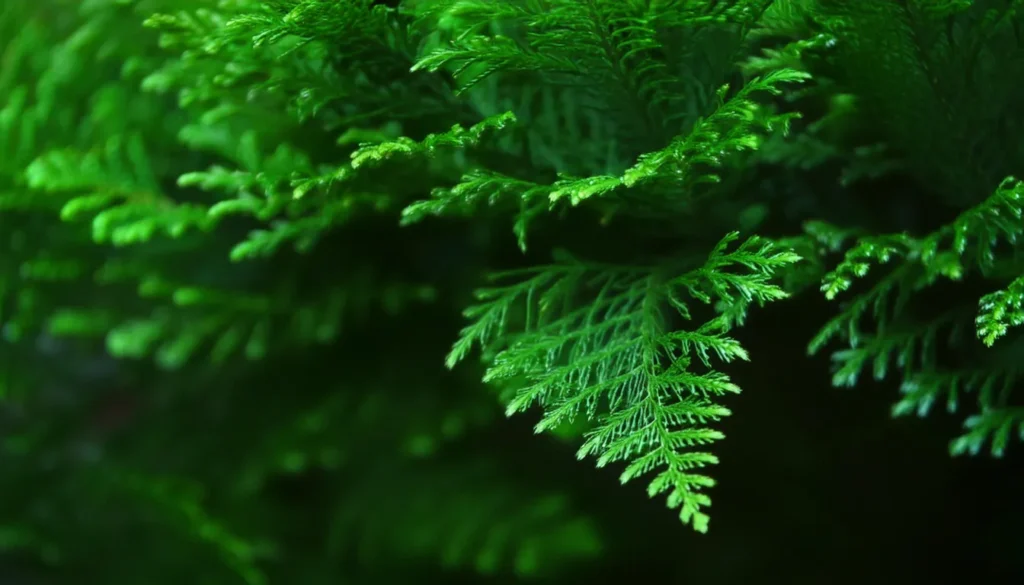
Quick Stats
| Attribute | Details |
| Scientific Name | Taxiphyllum “Peacock” |
| Common Name | Peacock Moss |
| Origin | Southeast Asia, particularly found in Thailand |
| Height | 1-3 cm (0.4-1.2 inches) |
| pH Range | 5.0 – 7.5 |
| CO2 Requirement | Low to Moderate |
| Growth Rate | Slow to Moderate |
| Care Level | Easy to Moderate |
| Color Form | Bright green with intricate patterns resembling peacock feathers |
| Water Conditions | 18-28°C (64-82°F), adaptable to a wide range of water parameters |
| Max Size | Typically remains small, forming dense mats |
| Lighting | Low to Moderate |
| Supplements | Minimal; benefits from occasional liquid fertilization |
| Placement | Foreground to Mid-ground |
| Propagation | By division or fragmentation |
What Is Taxiphyllum Sp (peacock moss)?
Taxiphyllum sp, commonly referred to as peacock moss, is a species of freshwater aquarium moss in the family Hypnaceae.
It is known for its delicate, feathery fronds, which resemble the vibrant plumage of a peacock.
This moss species is popular among aquarium enthusiasts due to its versatility, ease of care, and ability to enhance the aesthetic appeal of aquascapes.
Peacock moss is often used to:
- Create lush carpets
- Provide hiding places for aquatic life.
- Add a natural touch to aquarium decorations
Peacock moss is a versatile and visually appealing moss species that can transform your freshwater aquarium into a captivating underwater landscape.
Its delicate fronds create a lush carpet-like effect, which not only adds aesthetic appeal but also provides hiding places for your aquatic pets.
The feathery appearance of peacock moss closely resembles the vibrant plumage of a peacock, hence its common name.
This unique characteristic makes it a favorite choice among aquarists looking to create visually striking and natural-looking aquascapes.
Due to its low maintenance requirements, peacock moss is suitable for both beginner and experienced aquarium enthusiasts.
It can tolerate a wide range of water conditions, making it a hardy and easy-to-care-for moss species.

History And Origin
The history and origin of peacock moss can be traced back to Southeast Asia, particularly tropical regions such as Thailand, Vietnam, and Indonesia.
It is believed to have been discovered in the early 20th century and has since gained popularity among aquarium enthusiasts worldwide.
Peacock moss’s natural habitat consists of shaded forest floors, riverbanks, and other moist environments, where it thrives in the presence of adequate moisture and nutrients.
Its adaptability and striking appearance have made it a sought-after choice for aquarium landscaping.
| Origin | History | Aquatic Plant |
| Southeast Asia | Discovered in the early 20th century | Thrives in moist environments |
| Tropical regions | Popular among aquarium enthusiasts worldwide | Sought-after choice for aquarium landscaping |
Physical Characteristics
- Appearance: Peacock Moss features delicate, feather-like fronds that grow in dense clusters, resembling the tail feathers of a peacock. The fronds are thin and wiry, branching out in a distinctive pattern that adds depth and texture to aquarium landscapes.
- Coloration: The fronds of Peacock Moss typically exhibit vibrant shades of green, ranging from light to dark hues depending on factors such as lighting and water conditions. Under optimal conditions, the moss displays a rich and lustrous green coloration.
- Texture: Peacock Moss has a fine and feathery texture, with individual fronds composed of tiny, closely spaced leaves. This texture creates a soft and delicate appearance, making it an excellent choice for creating natural-looking aquascapes.
- Size: The size of Peacock Moss fronds can vary depending on environmental conditions and growth rate. Generally, the fronds range from a few millimeters to several centimeters in length, allowing the moss to form dense mats or carpets in aquariums.
Lighting Needs
- Low to Moderate Lighting: Peacock Moss can grow well under low to moderate lighting intensity. It does not require extremely bright lighting like some other aquatic plants, making it suitable for aquariums with basic lighting setups.
- Full-Spectrum Lighting: Provide full-spectrum aquarium lighting with a color temperature between 5000K to 7000K for optimal growth and coloration of Peacock Moss. Full-spectrum lighting mimics natural sunlight and supports photosynthesis, promoting healthy growth of the moss.
- Duration: Maintain a consistent photoperiod of 8 to 10 hours of light per day to simulate a natural day-night cycle. Avoid excessive or prolonged lighting periods, as this can lead to algae issues and stress for aquarium inhabitants.
- Avoid Direct Sunlight: While Peacock Moss can tolerate moderate lighting, direct sunlight should be avoided as it can cause excessive algae growth and potentially harm the moss. Place the aquarium in a location away from direct sunlight or use shading materials to diffuse light if necessary.
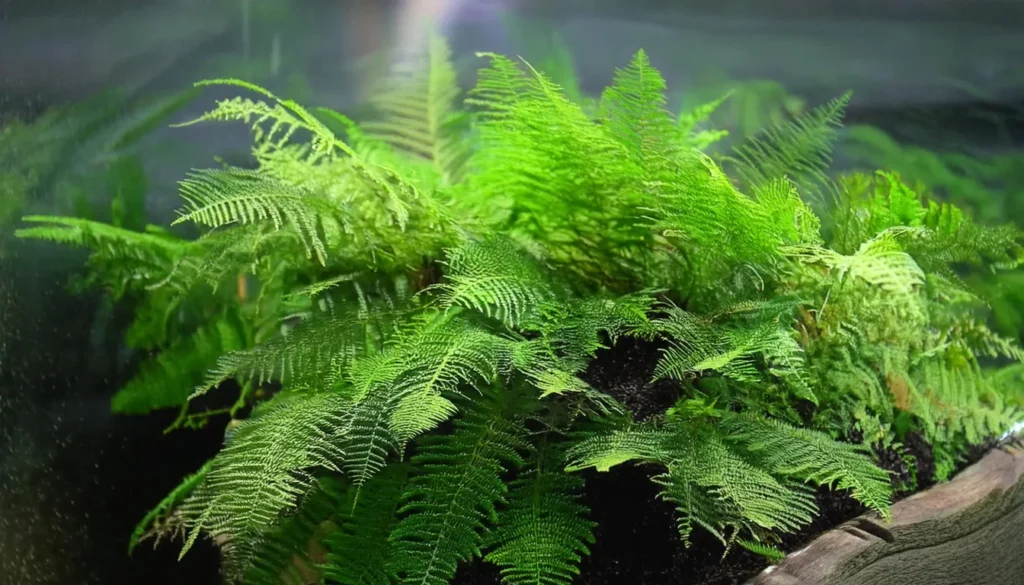
Temperature Parameters
- Temperature Range: Peacock Moss can thrive within a temperature range typically suitable for tropical freshwater aquariums. The ideal temperature range for Peacock Moss is approximately 20°C to 28°C (68°F to 82°F).
- Optimal Temperature: Within the recommended range, aim for a temperature around 22°C to 26°C (72°F to 79°F) for optimal growth and health of Peacock Moss. This temperature range closely mimics the conditions found in its native habitats in Southeast Asia.
- Stability: Maintain stable temperature conditions within the aquarium to prevent temperature fluctuations, which can stress the moss and inhibit its growth. Use a reliable aquarium heater and thermometer to monitor and regulate the water temperature consistently.
- Avoid Extremes: Avoid exposing Peacock Moss to temperature extremes outside of its preferred range, as this can lead to stress, reduced growth, and susceptibility to diseases. Sudden changes in temperature should also be avoided to prevent shock to the moss.
- Consider Tank Mates: When selecting the temperature for your aquarium, consider the temperature requirements of other fish and aquatic inhabitants coexisting with Peacock Moss. Choose a temperature that accommodates the needs of all aquarium inhabitants while ensuring the well-being of the moss.
- Seasonal Adjustments: Depending on the climate and seasonal changes in your location, you may need to adjust the aquarium temperature to maintain the desired range for Peacock Moss. Use a reliable aquarium heater with a thermostat to regulate the temperature as needed throughout the year.
Optimal Water Condition
- pH Level: Peacock Moss can thrive in a broad pH range, but it generally prefers slightly acidic to neutral conditions. Aim for a pH range between 6.0 and 7.5 for optimal growth and health of the moss.
- Water Hardness: Peacock Moss is adaptable to various water hardness levels, including soft to moderately hard water. It can tolerate a wide range of water hardness, with general hardness (GH) and carbonate hardness (KH) levels between 2 to 15 degrees dGH.
- Temperature: Maintain a stable temperature within the recommended range of approximately 20°C to 28°C (68°F to 82°F) for optimal growth of Peacock Moss. Avoid temperature fluctuations and extremes, as they can stress the moss and inhibit its growth.
- Lighting: Provide moderate to high-intensity lighting with a consistent photoperiod of 8 to 10 hours per day for Peacock Moss. Full-spectrum aquarium lighting with a color temperature between 5000K to 7000K is suitable for promoting healthy growth and coloration of the moss.
- Nutrient Levels: Peacock Moss is relatively undemanding in terms of nutrient requirements, but it benefits from a balanced nutrient regimen in the aquarium. Ensure adequate levels of essential nutrients, including nitrogen, phosphorus, potassium, iron, and trace elements, to support healthy growth of the moss.
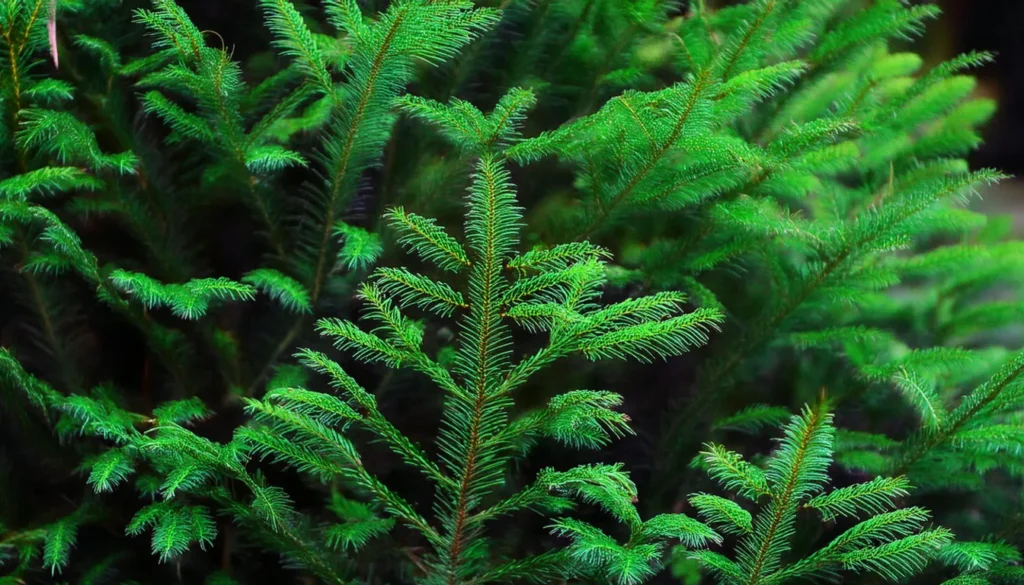
Substrate Requirement
- Substrate Type: Peacock Moss can grow on a variety of substrates, including sand, gravel, and aquatic soil. Choose a substrate that is inert and won’t affect water parameters, as Peacock Moss primarily attaches itself to surfaces rather than rooting into the substrate.
- Substrate Depth: While Peacock Moss doesn’t root deeply into the substrate, providing a shallow layer of substrate can offer stability for attaching the moss. Aim for a substrate depth of 1 to 2 inches (2.5 to 5 centimeters) to provide a suitable base for attaching Peacock Moss.
- Substrate Texture: Opt for a fine to medium-grained substrate with smooth texture to facilitate attachment of Peacock Moss. Avoid coarse or rough substrates that may damage the delicate fronds of the moss during attachment.
- Substrate Composition: Choose an aquarium substrate that is free of sharp edges, chemicals, and toxins that could harm Peacock Moss or aquarium inhabitants. Rinse the substrate thoroughly before adding it to the aquarium to remove any debris or contaminants.
- Substrate Preparation: Before attaching Peacock Moss to the substrate, prepare the substrate surface by cleaning it and removing any debris or algae. Smooth out the substrate surface to provide a flat and stable attachment area for the moss.
Placement Option
- Foreground: Placing Peacock Moss in the foreground of the aquarium can create a lush and vibrant carpeting effect. Attach the moss to the substrate in the front of the tank to form a dense mat, adding texture and visual interest to the lower portion of the aquascape.
- Midground: Peacock Moss can be positioned in the midground of the aquarium to complement other foreground and background plants. Use driftwood, rocks, or other hardscape elements as anchors for attaching the moss, creating a focal point in the middle portion of the tank.
- Background: While less common, Peacock Moss can also be used in the background of the aquarium to add depth and texture to the upper portion of the aquascape. Attach the moss to taller decorations or structures, allowing it to cascade downward and fill empty spaces in the background.
- Hardscape Accents: Peacock Moss can be attached to various hardscape elements such as rocks, driftwood, and aquarium decorations to create natural-looking accents. Use the moss to cover surfaces, crevices, and edges of hardscape elements, enhancing their appearance and blending them into the aquascape.
RELATED: Lilaeopsis Brasilensis: The Art Of Creating Aquatic Carpets
Recommended Tank Size
- Nano Tanks: Peacock Moss is well-suited for nano tanks and small aquarium setups due to its compact size and versatile placement options. It can be used to create lush foreground carpets, midground accents, or background fillers in nano tanks ranging from 5 gallons to 20 gallons.
- Medium-Sized Tanks: For medium-sized tanks ranging from 20 gallons to 50 gallons, Peacock Moss can be used to create intricate aquascapes with diverse layout options. It can be positioned as foreground carpets, midground focal points, or background accents, depending on the desired aesthetic and aquascape design.
- Large Tanks: In larger aquariums exceeding 50 gallons, Peacock Moss can be incorporated as part of a complex aquascape design, serving as foreground carpets, midground fillers, or background accents. Its versatility allows for creative placement options to achieve a balanced and visually appealing layout in larger tanks.
- Aquascaping Projects: Peacock Moss can also be used in aquascaping projects and competitions, where larger tank sizes are often utilized to create intricate and elaborate layouts. In these scenarios, Peacock Moss can be integrated into larger tanks ranging from 50 gallons to several hundred gallons, depending on the scale of the project.
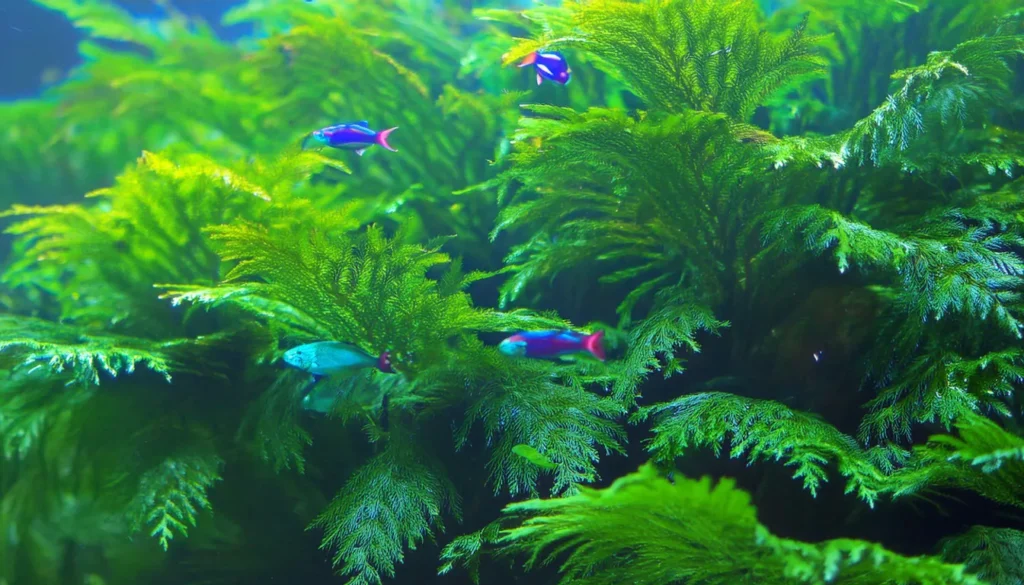
Suitable Tank Size
- Nano Tanks: Peacock Moss is well-suited for nano tanks and small aquarium setups. It can be used to create lush foreground carpets, midground accents, or background fillers in tanks ranging from 5 gallons to 20 gallons. Nano tanks offer limited space, making Peacock Moss an ideal choice for adding greenery and texture to small-scale aquascapes.
- Small to Medium-Sized Tanks: For small to medium-sized tanks ranging from 20 gallons to 50 gallons, Peacock Moss can be incorporated as part of diverse aquascape designs. It can be positioned as foreground carpets, midground focal points, or background accents, depending on the desired aesthetic and layout goals. Small to medium-sized tanks provide ample space for creating visually appealing aquascapes while accommodating the needs of various aquarium inhabitants.
- Large Tanks: In larger aquariums exceeding 50 gallons, Peacock Moss can be used to enhance complex aquascape designs. It can serve as foreground carpets, midground fillers, or background accents in larger tanks, providing texture and depth to the overall layout. Large tanks offer plenty of space for creating intricate and elaborate aquascapes, allowing for creative placement options and design possibilities.
Nutritional Needs
- Macronutrients: Peacock Moss requires essential macronutrients such as nitrogen (N), phosphorus (P), and potassium (K) for healthy growth. These nutrients can be supplied through regular aquarium fertilization using liquid or dry fertilizers formulated specifically for aquatic plants. Nitrogen is particularly important for promoting lush green growth in Peacock Moss.
- Micronutrients: In addition to macronutrients, Peacock Moss also benefits from micronutrients or trace elements, including iron, magnesium, calcium, and others. These micronutrients play crucial roles in various metabolic processes and enzyme functions within the moss. Liquid aquarium supplements containing trace elements can be used to provide these micronutrients to the moss.
- Carbon Dioxide (CO2): While not a strict nutritional requirement, supplementing carbon dioxide (CO2) in high-tech planted aquarium setups can enhance the growth and health of Peacock Moss. CO2 supplementation promotes photosynthesis, which is essential for plant growth, and can help prevent algae growth by promoting robust plant growth.
Peacock Moss Cultivation Tips
- Provide Optimal Lighting: Peacock Moss thrives under moderate to high-intensity lighting. Ensure that your aquarium receives adequate illumination to support photosynthesis and healthy growth of the moss. Use full-spectrum aquarium lighting with a color temperature between 5000K to 7000K for optimal results.
- Maintain Stable Water Parameters: Peacock Moss is adaptable to a wide range of water parameters, but stability is key to its health and growth. Maintain stable temperature, pH, and water hardness levels within the recommended ranges. Perform regular water changes and monitor water quality to ensure optimal conditions for the moss.
- Anchor the Moss Securely: Attach Peacock Moss to hardscape elements such as rocks, driftwood, or substrate using thread, fishing line, or aquarium-safe glue. Ensure that the moss is securely anchored to prevent it from floating away or becoming dislodged by water currents.
- Promote Water Circulation: Provide gentle to moderate water circulation within the aquarium to ensure adequate nutrient distribution and oxygenation. Avoid strong currents that may uproot or damage the moss, but maintain sufficient water movement to prevent stagnation and debris buildup.
RELATED: Planting The Perfect Lilaeopsis Novaezelandiae Carpet Plant At Home
Plant Propagation Tips
- Fragmentation: This plant naturally grows in dense mats with numerous branching fronds. To propagate the moss, simply divide the existing moss mat into smaller sections or fragments. Use sharp scissors or aquascaping tools to cut the moss into smaller portions, ensuring that each fragment has healthy and intact fronds.
- Anchor the Fragments: Once you have obtained the moss fragments, anchor them to desired surfaces within the aquarium. Attach the fragments to rocks, driftwood, substrate, or aquarium decorations using thread, fishing line, or aquarium-safe glue. Ensure that the moss fragments are securely attached to prevent them from floating away or becoming dislodged.
- Optimal Placement: When attaching the moss fragments, consider the desired aquascape layout and placement options. Position the fragments in areas where they will receive adequate lighting and water flow, promoting healthy growth and attachment. Spread the fragments evenly across the desired surface to achieve uniform coverage.
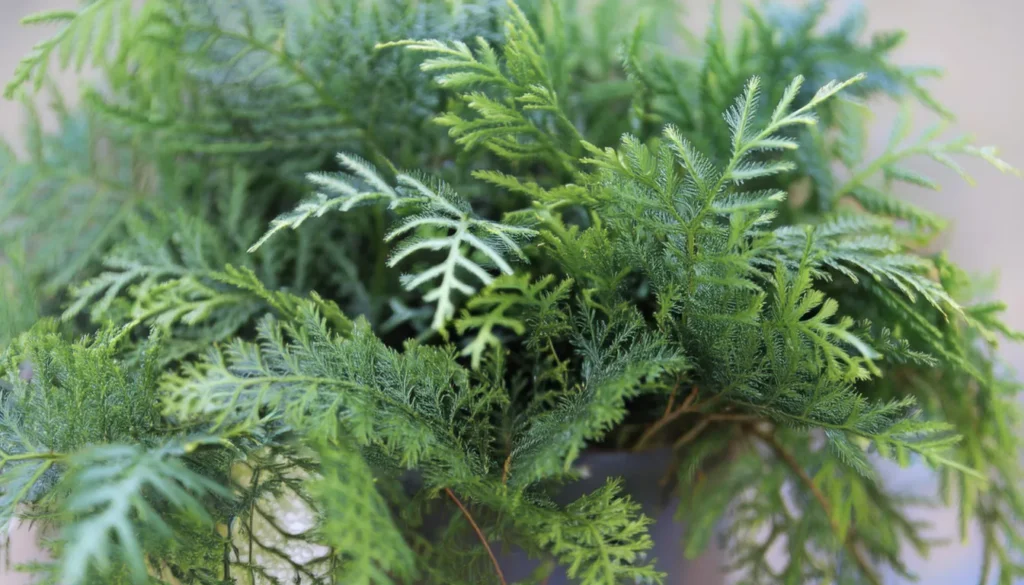
Benefits Of Planting Peacock Moss
- Natural Aesthetic Appeal: This plant adds a lush and natural look to the aquarium, mimicking the appearance of mosses found in natural aquatic habitats. Its delicate fronds and vibrant green coloration create a visually appealing contrast against hardscape elements such as rocks and driftwood.
- Versatile Aquascaping: This plant is highly versatile and can be used in various aquascaping styles, including Nature Aquarium, Iwagumi, and Dutch aquascapes. It can be positioned as foreground carpets, midground accents, or background fillers, offering endless possibilities for creative aquascape designs.
- Easy Maintenance: This plant is relatively low-maintenance compared to other aquarium plants. It does not require specialized care or CO2 supplementation, making it suitable for beginner aquarists and low-tech aquarium setups. Routine trimming and pruning are the primary maintenance tasks needed to keep the moss tidy and healthy.
- Natural Filtration: Like other aquatic plants, this plant helps improve water quality by absorbing nutrients such as nitrates and phosphates from the water column. It also provides a surface area for beneficial bacteria to colonize, contributing to biological filtration in the aquarium and promoting a healthier aquatic environment.
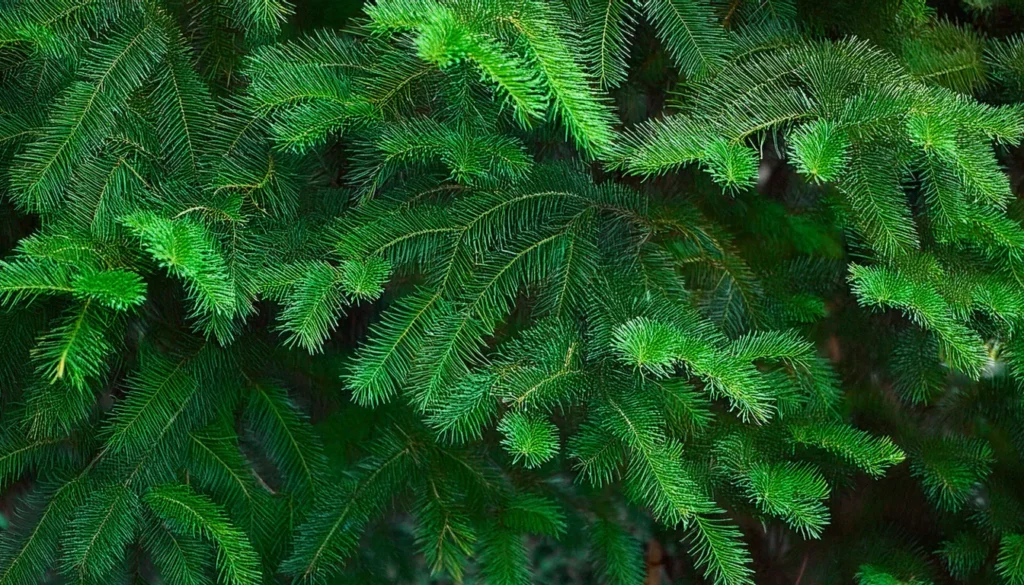
Conclusion
Peacock moss, or Taxiphyllum sp., is a captivating and versatile aquatic plant that adds a touch of enchantment to freshwater aquariums.
Its striking appearance, low maintenance requirements, and numerous benefits make it a favored choice among aquarium enthusiasts.
By following the provided care tips, addressing common challenges, and exploring creative ways to incorporate this plant into your aquarium layouts, you can create a stunning underwater landscape that enhances the aesthetic appeal of your freshwater aquarium and provides a thriving environment for your aquatic life.
Whether you are a beginner or experienced aquarium enthusiast, this plant offers endless possibilities for aquarium landscaping.
Its delicate fronds and vibrant green color create a lush and natural appearance, elevating the visual appeal of any aquascape.
With its ease of care and ability to replicate biotopes, this plant allows you to bring a piece of nature into your freshwater aquarium.
Frequently Asked Questions
What Care Tips Should I Keep In Mind For Peacock Moss?
Understanding the pH requirements and hardiness of this plant is crucial.
It generally thrives in a pH range of 6-8 and can tolerate a wide range of water hardness. Additionally, consider the benefits and considerations of CO2 injection for enhancing growth and coloration.
What Benefits Does Peacock Moss Offer In Aquatic Environments?
This plant provides shelter, breeding grounds, and hiding places for aquatic organisms, contributing to habitat enrichment.
It also adds texture, visual interest, and a natural touch to aquarium layouts, making it popular for aquascaping and recreating realistic underwater landscapes.
Are There Any Common Myths About Low-Maintenance Plants Like Peacock Moss?
Yes, there are often misconceptions surrounding low-maintenance plants.
In the case of this plant, we will debunk common myths and misconceptions regarding their care, maintenance, and growth.
How Can I Incorporate Peacock Moss Into My Aquarium Landscaping?
This plant can be used to create naturalistic layouts in aquariums, adding a lush and natural appearance.
We will explore various techniques and ideas for incorporating this plant into your aquarium landscaping, helping you create visually stunning underwater environments.
What Challenges Might I Face When Planting Peacock Moss In My Aquarium?
Common challenges include nutrient deficiencies or excesses, introducing pests or diseases through new plants, and maintaining a balanced ecosystem.
We will discuss practical solutions and strategies to address these challenges and ensure the thriving growth of peacock moss in your aquarium.
- Unveiling The Wonders Of Riccia Fluitans In Aquascapes - August 7, 2024
- Vallisneria Gigantea Var. Guide To Care And Cultivation At Home - July 31, 2024
- Vesicularia Dubyana Care & Growth Guide Tips For Beginner Gardeners - July 30, 2024
